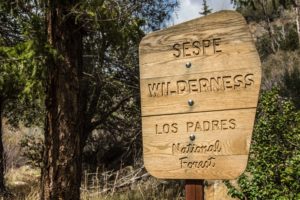Many people think of wilderness as an area that has seen limited human impact, is uncultivated, and maybe has a lot of trees. Perhaps some deer or coyotes might roam through it, and a condor might fly overhead every once in a while. While in one sense of the word, this is an accurate description of wilderness, our work with wilderness focuses on another definition – a legislative one.
In 1964, Congress passed into law the Wilderness Act, which gives Congress the authority to permanently designate the highest level of protection for any of our existing public lands. With wilderness designation, the traditional threats to our wild lands such as road building, oil developments, mining, off-road vehicle use, logging, and more, are no longer allowed in that designated area. We can still enjoy those lands via hiking, backpacking, camping, fishing, hunting, and horseback riding, but the idea is that we visit, and then leave it as we found it.
The most common question we are asked is “How does this compare to our other public lands? What about national forests? National parks? National monuments? Aren’t those areas already protected?” Somewhat, yet many of those aforementioned threats are permissible in our public lands. A national forest, like Los Padres, is designed to be a “land of many uses,” and uses such as oil drilling, mining, logging and more are all allowed within its boundaries. Even in National Parks where hunting, grazing, logging and mining are all prohibited, the threats of roads, development, and overuse still exist.
U.S. presidents can declare an area as a national monument, (a tool that many presidents have used when they felt Congress was not acting quickly enough in passing protective legislation), however, national monument designation protects existing rights (including mining, drilling, etc.) and can be managed in a variety of ways, some of which aren’t protective. To reiterate, while many of our public lands are somewhat protected, Congress-designated wilderness is the best and most permanent form of protection possible.
In addition to Congressionally-designated wilderness, there are other means by which an area can be managed as wilderness, but they are not without issue. Public land management agencies (such as the Bureau of Land Management) can determine land to be a “wilderness study area,” and a president can designate “proposed wilderness areas” in preparation for legislation passing to make the designations official. While designated as potential wilderness or a wilderness study area, the land is managed as though it was already awarded legal designation. However, these designations are not permanent and the protection can be revoked. For example, on January 28, 2015, the Senate attempted to pass an amendment to the Keystone XL bill that would have stripped protection from 27.4 million acres of designated wilderness study areas and proposed wilderness areas – including areas of the Los Padres and the Carrizo Plain. While the amendment was unsuccessful in passing, without Congressional legislation those management designations remain temporary and at risk of being stripped of their protection.
ForestWatch is proudly working to add wilderness areas throughout the Los Padres and Carrizo Plain. Along with our Central Coast Wild Heritage coalition partners, who include members of The Wilderness Society, Pew Charitable Trusts, California Wilderness Coalition, Friends of the River, and Keep the Sespe Wild, we are continuing to gather support for the Central Coast Heritage Protection Act. This bill will protect 245,500 acres of the Los Padres and Carrizo Plain as wilderness, safeguard 159,000 miles of wild and scenic rivers, and establish the Condor Trail, a 400-mile national recreation trail running through the central coast.
Photos by Bryant Baker









